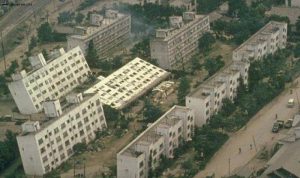
Several strong earthquakes around the world have resulted in a phenomenon called soil liquefaction, the seismic generation of excess porewater pressures and softening of granular soils, often to the point that they may not be able to support the foundations of buildings and other infrastructure. The November 2016 earthquake in New Zealand, for example, resulted in liquefaction that caused serious damage to the Port of Wellington, which contributes approximately $1.75 billion to the country’s annual GDP. An estimated 40 percent of the U.S. is subject to ground motions severe enough to cause liquefaction and associated damage to infrastructure.
Effectively engineering infrastructure to protect life and to mitigate the economic, environmental, and social impacts of liquefaction requires the ability to accurately assess the likelihood of liquefaction and its consequences. A new report by the National Academies of Sciences, Engineering, and Medicine evaluates existing field, laboratory, physical model, and analytical methods for assessing liquefaction and its consequences, and recommends how to account for and reduce the uncertainties associated with the use of these methods.
When liquefaction occurs, wet granular materials such as sands and some silts and gravels can behave in a manner similar to a liquid. The most commonly used approaches to estimate the likelihood of liquefaction are empirical case-history-based methods initially developed more than 45 years ago. Since then, variations to these methods have been suggested based not only on case historical data but also informed by laboratory and physical model tests and numerical analyses. Many of the variations are in use, but there is no consensus regarding their accuracy. As a result, infrastructure design often incurs additional costs to provide the desired confidence that the effects of liquefaction are properly mitigated.
The report evaluates existing methods for assessing the potential consequences of liquefaction, which are not as mature as those for assessing the likelihood of liquefaction occurring. Improved understanding of the consequences of liquefaction will become more important as earthquake engineering moves more toward performance-based design.
“The engineering community wrestles with the differences among the various approaches used to predict what triggers liquefaction and to forecast its consequences,” said Edward Kavazanjian, Ira A. Fulton Professor of Geotechnical Engineering and Regents’ Professor at Arizona State University and chair of the committee that conducted the study and wrote the report. “It’s important for the geotechnical earthquake engineering community to consider new, more robust methods to assess the potential impacts of liquefaction.”
The committee called for greater use of principles of geology, seismology, and soil mechanics to improve the geotechnical understanding of case histories, project sites, and the likelihood and consequences of liquefaction. The committee also emphasized the need for explicit consideration of the uncertainties associated with data used in assessments as well as the uncertainties in the assessment procedures.
The report recommends establishing standardized and publicly accessible databases of liquefaction case histories that could be used to develop and validate methods for assessing liquefaction and its consequences. Further, the committee suggested establishing observatories for gathering data before, during, and after an earthquake at sites with a high likelihood of liquefaction. This would allow better understanding of the processes of liquefaction and the characteristics and behavior of the soils that liquefied. Data from these sites could be used to develop and validate assessment procedures.
Note: The above post is reprinted from materials provided by National Academies of Sciences, Engineering, and Medicine.










